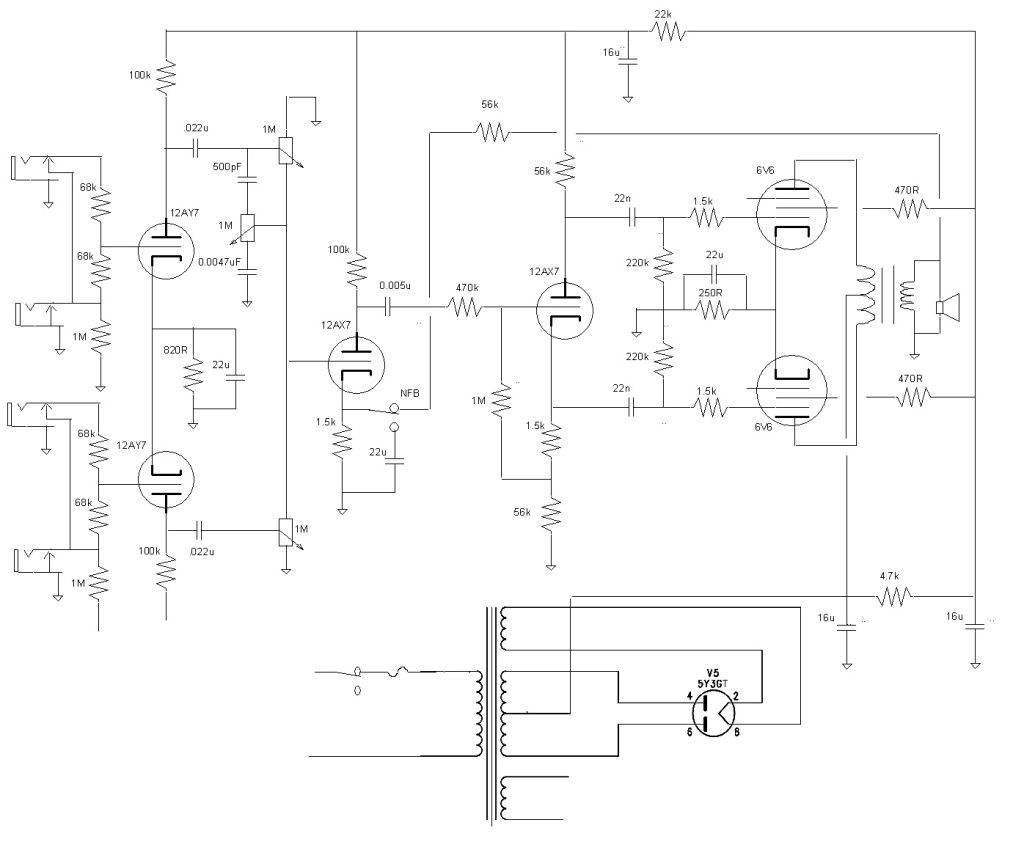Hey all, I'm new to this forum and as a tech who is still wet behind the ears, I want to reach out and ask for help! I built a 5E3 Tweed Deluxe kit from mojotone, and hand built the cab.

Unfortunately, it's not quite the sound I'm looking for, so I am going to attempt a few mods. First, I do a lot of fast fingerpicking on an archtop I built with a Kent Armstrong Mini humbucker, and the Deluxe seems to have an overwhelming amount of bass, and a tone that is not clear or immediate enough for my liking. I also play a Les Paul Jr. copy i made a lot with Lindy Fralin P90's, and I LOVE the tones I get out of it, but I would like to be able to play cleanly at louder volumes (the signal distorts around 6 or 7 on the volume knob). SO, Here are the mods I was thinking:
--Switchable SS rectifier, to create more headroom and a versatility between my folky archtop/acoustic playing and the bluesy, distorted feel on my electric.
--Adding a pot for adjustable gain, allowing me to choose the amount of distortion to add.
My first question is, are these mods appropriate to acheive the sounds I want out of the amp?
Second, it's my understanding that the cathode biasing resistors are the main contributing factor to gain control. It stands to reason (in my inexperienced brain) that replacing one of these resistors with a potentiometer would give me gain control, since potentiometers are effectively variable resistors. Is this correct? If so, which tube should I wire this pot to? Also, what value pot should I use? Are there any special precautions I should take?
Third, I'm not sure if the switchable rectifier mod would be a better solution to the heavy bass tones than changing the coupling caps to a lower value, or if I should do both.
Are there any other mods that you guys would suggest or are particularly fond of?
I'm slowly but surely becoming more acclimated to tube circuitry, but I'm still very much a novice, so I appreciate any help you can offer. For the sake of ease, here is the schematic I used:

Unfortunately, it's not quite the sound I'm looking for, so I am going to attempt a few mods. First, I do a lot of fast fingerpicking on an archtop I built with a Kent Armstrong Mini humbucker, and the Deluxe seems to have an overwhelming amount of bass, and a tone that is not clear or immediate enough for my liking. I also play a Les Paul Jr. copy i made a lot with Lindy Fralin P90's, and I LOVE the tones I get out of it, but I would like to be able to play cleanly at louder volumes (the signal distorts around 6 or 7 on the volume knob). SO, Here are the mods I was thinking:
--Switchable SS rectifier, to create more headroom and a versatility between my folky archtop/acoustic playing and the bluesy, distorted feel on my electric.
--Adding a pot for adjustable gain, allowing me to choose the amount of distortion to add.
My first question is, are these mods appropriate to acheive the sounds I want out of the amp?
Second, it's my understanding that the cathode biasing resistors are the main contributing factor to gain control. It stands to reason (in my inexperienced brain) that replacing one of these resistors with a potentiometer would give me gain control, since potentiometers are effectively variable resistors. Is this correct? If so, which tube should I wire this pot to? Also, what value pot should I use? Are there any special precautions I should take?
Third, I'm not sure if the switchable rectifier mod would be a better solution to the heavy bass tones than changing the coupling caps to a lower value, or if I should do both.
Are there any other mods that you guys would suggest or are particularly fond of?
I'm slowly but surely becoming more acclimated to tube circuitry, but I'm still very much a novice, so I appreciate any help you can offer. For the sake of ease, here is the schematic I used:

Comment